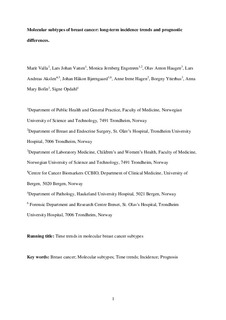Molecular Subtypes of Breast Cancer: Long-term Incidence Trends and Prognostic Differences
Valla, Marit; Vatten, Lars Johan; Engstrøm, Monica J; Haugen, Olav Anton; Akslen, Lars A.; Bjørngaard, Johan Håkon; Hagen, Anne Irene; Ytterhus, Borgny; Bofin, Anna M.; Opdahl, Signe
Journal article, Peer reviewed
Accepted version
Permanent lenke
http://hdl.handle.net/11250/2478359Utgivelsesdato
2016Metadata
Vis full innførselSamlinger
Originalversjon
10.1158/1055-9965.EPI-16-0427Sammendrag
Background: Secular trends in incidence and prognosis of molecular breast cancer subtypes are poorly described. We studied long-term trends in a population of Norwegian women born 1886–1977.
Methods: A total of 52,949 women were followed for breast cancer incidence, and 1,423 tumors were reclassified into molecular subtypes using IHC and in situ hybridization. We compared incidence rates among women born 1886–1928 and 1929–1977, estimated age-specific incidence rate ratios (IRR), and performed multiple imputations to account for unknown subtype. Prognosis was compared for women diagnosed before 1995 and in 1995 or later, estimating cumulative risk of death and HRs.
Results: Between 50 and 69 years of age, incidence rates of Luminal A and Luminal B (HER2−) were higher among women born in 1929 or later, compared with before 1929 [IRRs 50–54 years; after imputations: 3.5; 95% confidence interval (CI), 1.8–6.9 and 2.5; 95% CI, 1.2–5.2, respectively], with no clear differences for other subtypes. Rates of death were lower in women diagnosed in 1995 or later, compared to before 1995, for Luminal A (HR 0.4; 95% CI, 0.3–0.5), Luminal B (HER2−; HR 0.5; 95% CI, 0.3–0.7), and Basal phenotype (HR 0.4; 95% CI, 0.2–0.9).
Conclusions: We found a strong secular incidence increase restricted to Luminal A and Luminal B (HER2−) subtypes, combined with a markedly improved prognosis for these subtypes and for the Basal phenotype.
